Horizon Europe Atlas: Regions' participation in the Framework Programme
15/11/2024

In the context of the Research and Innovation Framework Programmes (FPs), there is perhaps nothing more closely followed than the European Research Council (ERC) grants. Since 2007, the ERC has funded frontier projects (grants), mainly in basic research, in a wide range of research areas. ERC grants are designed to support the original ideas and intentions of outstanding researchers at different stages of their scientific development. Researchers can choose their own research topic. The award of an ERC grant is considered one of the high points of a researcher's career. Research centres (host institutions) where ERC grants are implemented gain a high reputation and prestige in the scientific world. ERC grants are seen as an important indicator of the quality of the research environment, both at the level of the host institutions themselves and of the countries where the host institutions are located. The ERC does not support networks or international consortia, but individual Principal Investigators (PIs) and their research teams. ERC grants are mainly individual in nature and can be divided into three main types: ERC Starting Grants (ERC-STG) - supporting outstanding young and early career researchers (Ph.D. 2-7 years) who are establishing their own independent research team or programme, ERC Consolidator Grants (ERC-COG) - supporting researchers who are consolidating their own independent research team or programme (Ph.D 7-12 years), and ERC Advanced Grants (ERC-ADG) - support outstanding researchers at a stage in their career when they are already established senior researchers with a recognised reputation for research excellence.
ERC Synergy Grants (ERC-SYG) are another type of grant that will not be covered in the analysis below. These grants are intended to support a group of 2-4 principal investigators and their teams to jointly solve a cutting-edge research project. We will also not analyse ERC Proof of Concept Grants (ERC-POC), which are aimed at supporting already successful ERC grantees at the earliest stage of exploiting the results of their research activities and bringing them into practice.
Funding for each ERC grant is based on a detailed evaluation of the project proposal and its applicant. The project success rate of a given country used in this analysis corresponds to the percentage of approved and funded project proposals developed by researchers in collaboration with the host institutions of that country to the total number of project proposals submitted by applicants intending to work on an ERC grant in that country. However, the overall project success rate at country level varies widely from one FP to another. It depends mainly on the ratio between the available budget for the ERC programme in a given FP, the total number of project proposals submitted and the number of ERC projects funded. For example, a project success rate of 10% has a slightly different weighting in FP7 (FP7), a different weighting in Horizon 2020 (H2020) and a different weighting in Horizon Europe (HE) given these parameters. Each FP is specific for these reasons and it is therefore not optimal to compare absolute project success rates across FPs. In order to get an idea of the quantity (intensity of participation) and quality of proposals submitted in each FP in the different types of projects and ERC research domains from the perspective of the Czech Republic, it will be useful to express these indicators in relative terms, namely as an activity index and a success index.
The Czech activity index compares the proportion of "Czech" project proposals (i.e. project proposals submitted by researchers from the Czech Republic and abroad in collaboration with a host institution based in the Czech Republic) of a given ERC grant type or ERC domain with the proportion of all project proposals submitted by ERC grant applicants (of a given grant type or domain) through host institutions based in the European countries considered. The more intensive the activity of the Czech Republic in submitting ERC project proposals, the higher the value of the activity index. An activity index value below 1 means that there is insufficient activity by researchers from the Czech Republic and abroad who intended to work on an ERC grant in the Czech Republic. A value of 1 indicates equal activity and a value above 1 indicates that activity in the CR is above average. For example, if 51% of all submitted Czech ERC project proposals in the H2020 programme relate to the Physical Sciences (PE) domain and this domain accounts for only 44% of all project proposals in the H2020 programme overall, this gives an index value of 1.15, reflecting above average activity of the Czech Republic in this domain in the H2020 programme.
In a similar way, we can determine the success index of ERC project proposals that researchers intended to work on in Czech host institutions. The success index of "Czech" project proposals reflects the ratio of the success rate of applications submitted by ERC grant applicants in collaboration with Czech host institutions to the success rate of applications from all countries in a given grant type or research area - domain. In terms of the range of values, the success index behaves in the same way as the activity index: the higher the success rate of "Czech" project proposals compared to the overall success rate, the higher the index value. For example, if in the H2020 programme the overall project success rate for Advanced Researcher Grants (ERC-ADG) is 10.3% and in the case of the Czech Republic only 2.2%, the Czech success index for these types of ERC grants comes out at 0.2, which is well below the value of 1 and implies that the Czech Republic has a significantly below average success rate compared to all countries in this programme and in this type of ERC grant. Let us add that in developed Western European countries both indices usually exceed the value of 1.5 and in some cases even the value of 2 is reached and exceeded.
The graphical representation of the activity and success indexes for each ERC grant type in FP7, H2020 and HE (Figure 1) shows that the success rate of project proposals submitted by ERC grant applicants in collaboration with Czech host institutions is below the overall European average for all three ERC grant types - (bottom two quadrants of Figure 1, indicated by the horizontal line of the index, success index = 1). The activity of applicants intending to pursue an ERC grant at Czech host institutions is at a solid level in all three FPs compared for the ERC Starting Grant (ERC-STG). Activity indices exceed the value of 1. In contrast, the activity of applicants intending to address an ERC grant in Czech host institutions is insufficient compared to the European average in all three FPs for ERC grants for experienced researchers (ERC-ADG) and also for ERC consolidation grants (ERC-COG) submitted in FP7 and in the HE programme so far.
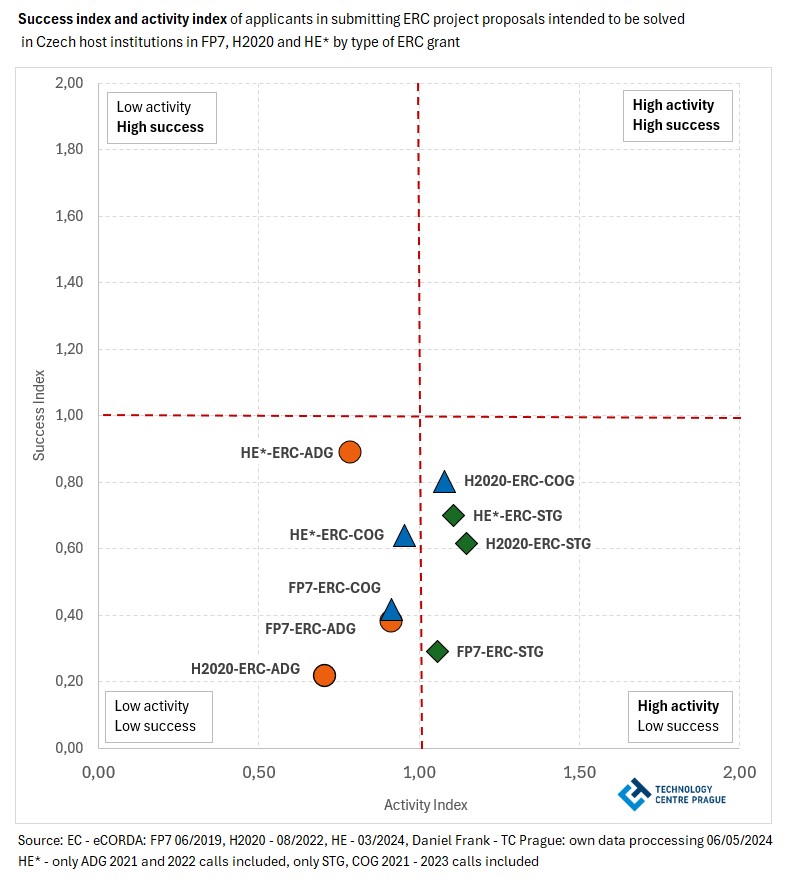
Figure 1: Success index and activity index of applicants in submitting ERC project proposals intended to be solved in Czech host institutions in FP7, H2020 and HE* by type of ERC grant
Figure 2 shows in more detail the time trend of the activity index of applicants for different types of ERC grants who intended to work on these grants in Czech host institutions in FP7, in the H2020 programme and in the HE programme so far. Figure 2 shows that the activity of applicants for all three types of ERC grants linked to the Czech research environment has not been increasing over time, but rather stagnating. The highest activity is observed among researchers applying for young starting outstanding scientist grants (ERC-STG), slightly lower activity is found among researchers applying for Consolidation grants for young established researchers (ERC-COG), and the lowest activity is among senior researchers applying for advanced researcher grants (ERC-ADG). The activity of researchers towards ERC grants in the Czech Republic decreases with their increasing age, length of their scientific career, but also with the difficulty of the ERC grant type.
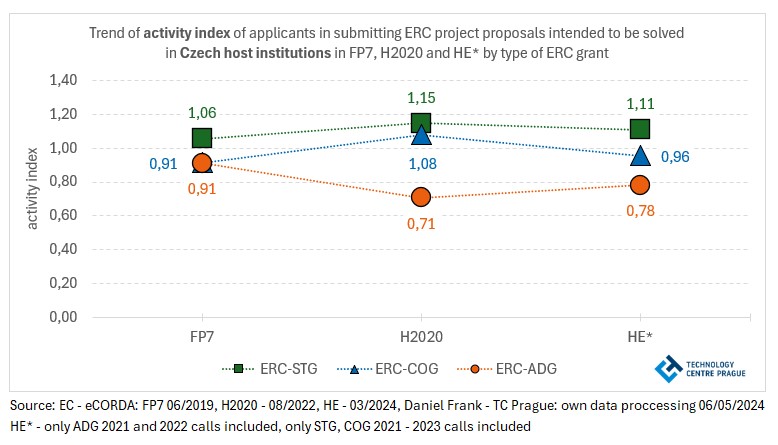
Figure 2: Trend of activity index of applicants in submitting ERC project proposals intended to be solved in Czech host institutions in FP7, H2020 and HE* by type of ERC grant
While the activity of researchers in the Czech research area towards ERC grants has been rather stagnant in the long term, the project success rate, or rather the success index, has been increasing over time - Figure 3. The increase in the success rate is most evident in the case of ERC Starting Grants (ERC-STG). For the remaining two grant types, the rising trend in success rates is not so clear, but it can be said that project success rates are not decreasing in the long term, as the success index for ERC-COG and ERC-ADG is significantly higher than in FP7 over the lifetime of the HE programme. It should be added that all achieved success index values for all ERC grant types are below 1, which means that although success rates are increasing over time, they are still relatively well behind the European average.
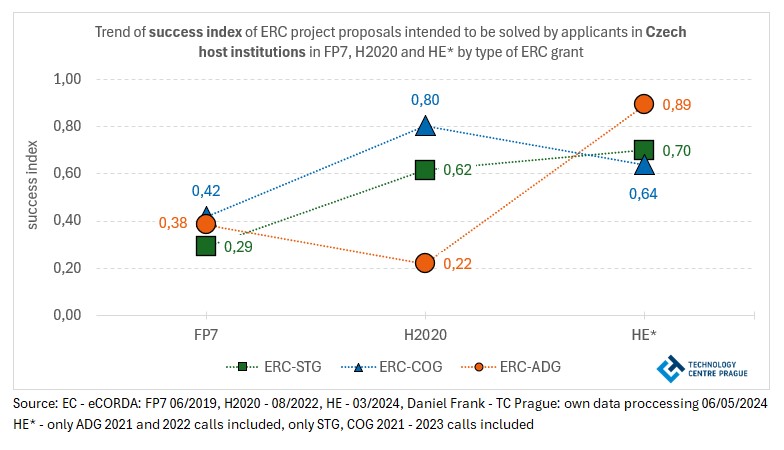
Figure 3: Trend of success index of applicants in submitting ERC project proposals intended to be solved in Czech host institutions in FP7, H2020 and HE* by type of ERC grant
Similarly to the ERC grant types, we can also determine activity and success indexes for the three main research domains offered by the ERC programme - Figure 4: Physical Sciences and Engineering (PE), Life Sciences (LS) and Social Sciences and Humanities (SH). At a first glance, it can be seen that the most active researchers are those who intended to work on an ERC grant in the physical sciences (FP7-ERC-PE, H2020-ERC-PE, HE-ERC-PE). The activity index ranges from 1.12 to 1.24. The activity of ERC grant applicants in the field of natural sciences in Horizon 2020 and in the HE programme so far (H2020-ERC-LS, HE-ERC-LS) is comparable to the European average. In terms of the success index in submitting ERC project proposals divided by FP and research domains, the Czech Republic is relatively weak compared to the European average. Researchers and their project proposals from the social sciences in the H2020 programme (H2020-ERC-SH) and from the natural sciences in the HE programme so far (HE-ERC-LS) are an exception. However, these two positive cases seem to reflect a current situation rather than any longer-term trend.
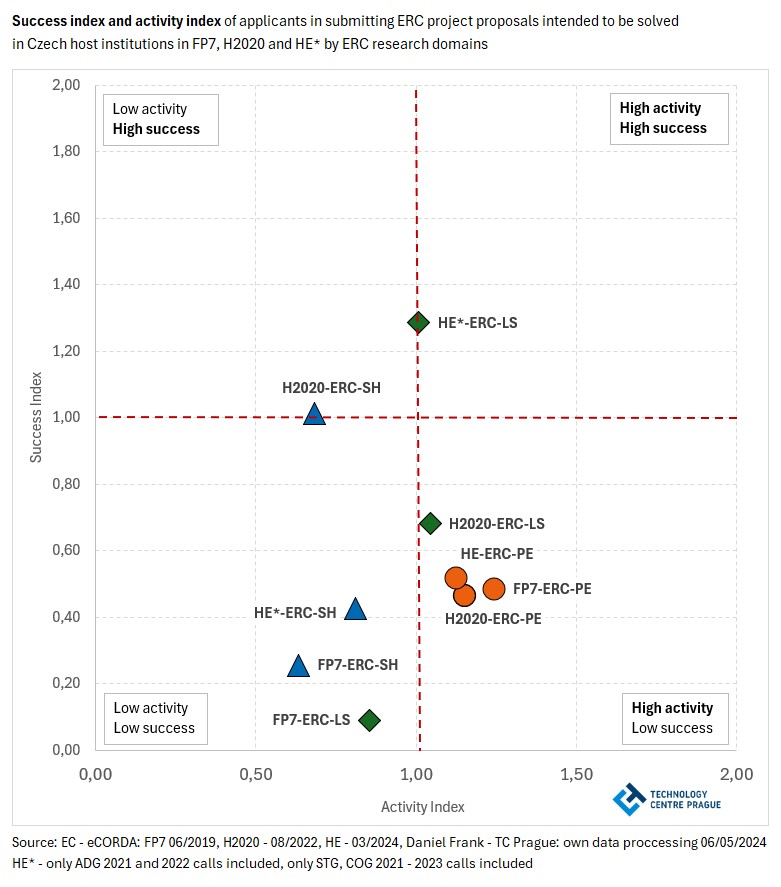
Figure 4: Success index and activity index of applicants in submitting ERC project proposals intended to be solved in Czech host institutions in FP7, H2020 and HE* by ERC research domains
Figure 5 shows in more detail the time trend of the activity index of ERC grant applicants from different research areas who intended to work on these grants in Czech host institutions in FP7, in the H2020 programme and in the HE programme so far. The decreases and increases in the activity index are very small. A very slight increase in activity can be observed among researchers submitting ERC proposals for projects in the social humanities (ERC-SH). However, the level of the activity index remains well below the European average in the long term. On the contrary, there is a very, very slight decrease in the activity of researchers preparing project proposals in the field of physical sciences and engineering (ERC-PE). Here, the activity index level remains above the European average in the long term.
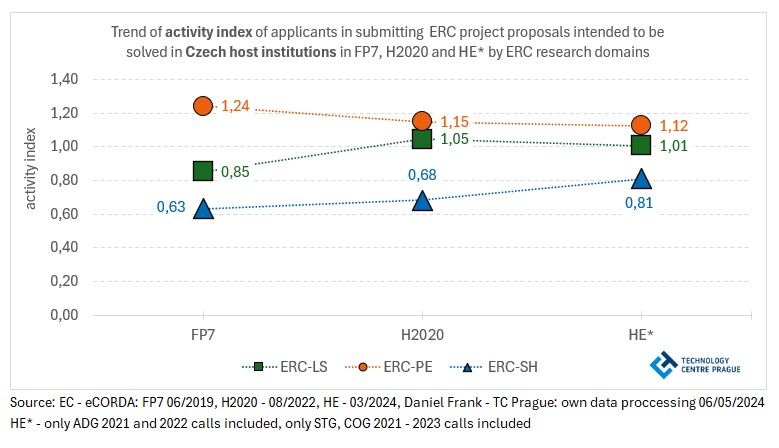
Figure 5: Trend of activity index of applicants in submitting ERC project proposals intended to be solved in Czech host institutions in FP7, H2020 and HE* by ERC resarch domains
The time trend of the success rate of ERC project proposals to be implemented in Czech host institutions in FP7, H2020 and HE across the ERC research domains is the most varied - Figure 6. The success rate index, which refers to the submission of project proposals that are included in the ERC-LS panels, has a significantly increasing trend. In the course of the HE programme so far, the value of this index has increased significantly above 1, which means that applicants for these ERC grants in collaboration with Czech host institutions are more successful than the European average. This rising trend in success rates for these project proposals is mainly driven by younger career researchers - applicants for STG and COG grants. The success rate index has stagnated over time for ERC project proposals with topics in the physical sciences and engineering (ERC-PE). The average success rate of ERC grant applicants in Europe is roughly twice as high in this research domain compared to ERC grant applicants in the Czech research environment. The success index for ERC project proposals focusing on social sciences and humanities (ERC-SH) has a very fluctuating trend. The relatively high success index in the H2020 programme is due to several successful ERC grants in the Czech Republic in this area in this FP.
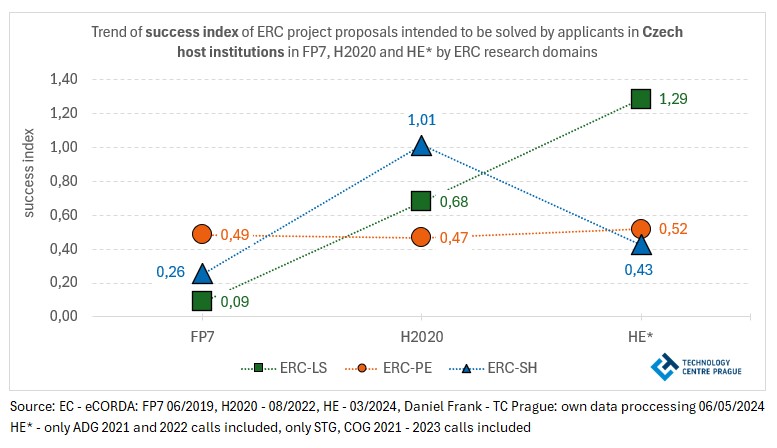
Figure 6: Trend of success index of applicants in submitting ERC project proposals intended to be solved in Czech host institutions in FP7, H2020 and HE* by type ERC research domains
In Table 1 below we present for completeness the actual project success rates of the Czech Republic, the aggregated project success rates of all countries and the success indexes by ERC grant type and ERC research area. The table includes overall data for FP7, the H2020 programme and current data for the HE programme.
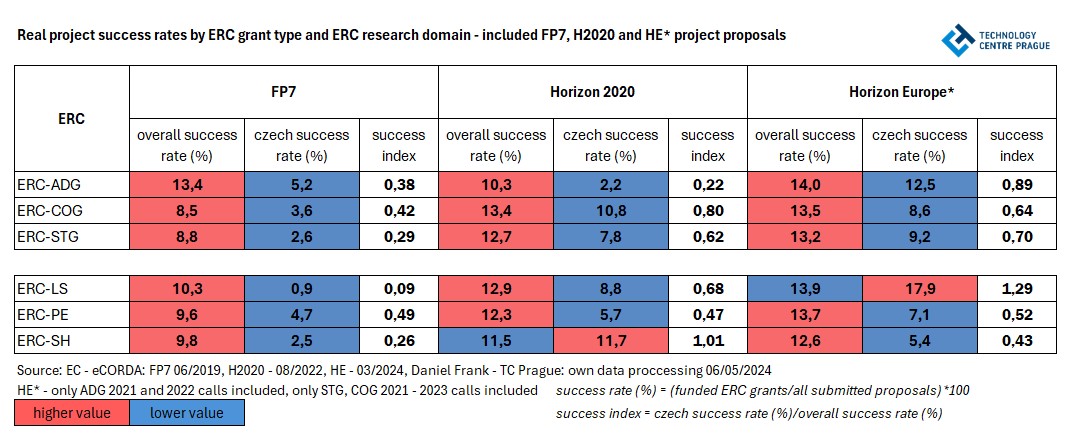
Table 1: Real project success rates by ERC grant type and ERC research domain - included FP7, H2020 and HE* project proposals
It should be noted that although the ERC grant that researchers receive is not linked to a specific institution but to the researcher, the geographical location of the institution, not the nationality of the applicant or the place where the researcher studied, determines which country is awarded an ERC grant in the eCORDA database. For these reasons, the above results of this analysis should be related to the Czech research environment and Czech host institutions, not only to ERC grant applicants with Czech nationality. For completeness, however, let us look at what the project success rates and success index values would look like for Czech researchers only (researchers with Czech nationality). Table 2, which is somewhat less clear, shows that ERC grant applicants from abroad (non-Czech nationality) who intended to work on the grant at Czech host institutions statistically significantly reduce the overall success rate of projects in the Czech Republic (cf. success rates - first and second columns of Table 2). This is particularly evident in the H2020 and HE programmes. Significant differences in success rates are observed for ERC project proposals focused on natural sciences and intended for the careers of younger researchers (ERC-STG, COG). Although the internationalisation of the Czech research area is gradually increasing and the share of foreign applicants for ERC grants in the Czech Republic is increasing rapidly (in FP7 10 %, in H2020 26 %, in HE 40% of applicants for ERC grants in the Czech Republic - author's own calculations), it is not possible to attract many truly successful and top researchers to the Czech research environment. The vast majority of project proposals submitted by foreign applicants (mostly from Slovakia, Ukraine and other Eastern European countries, or third countries in South America and Asia) are not of sufficient quality to be funded. This is added to the fact that the evaluation of an ERC project proposal also evaluates the applicant.
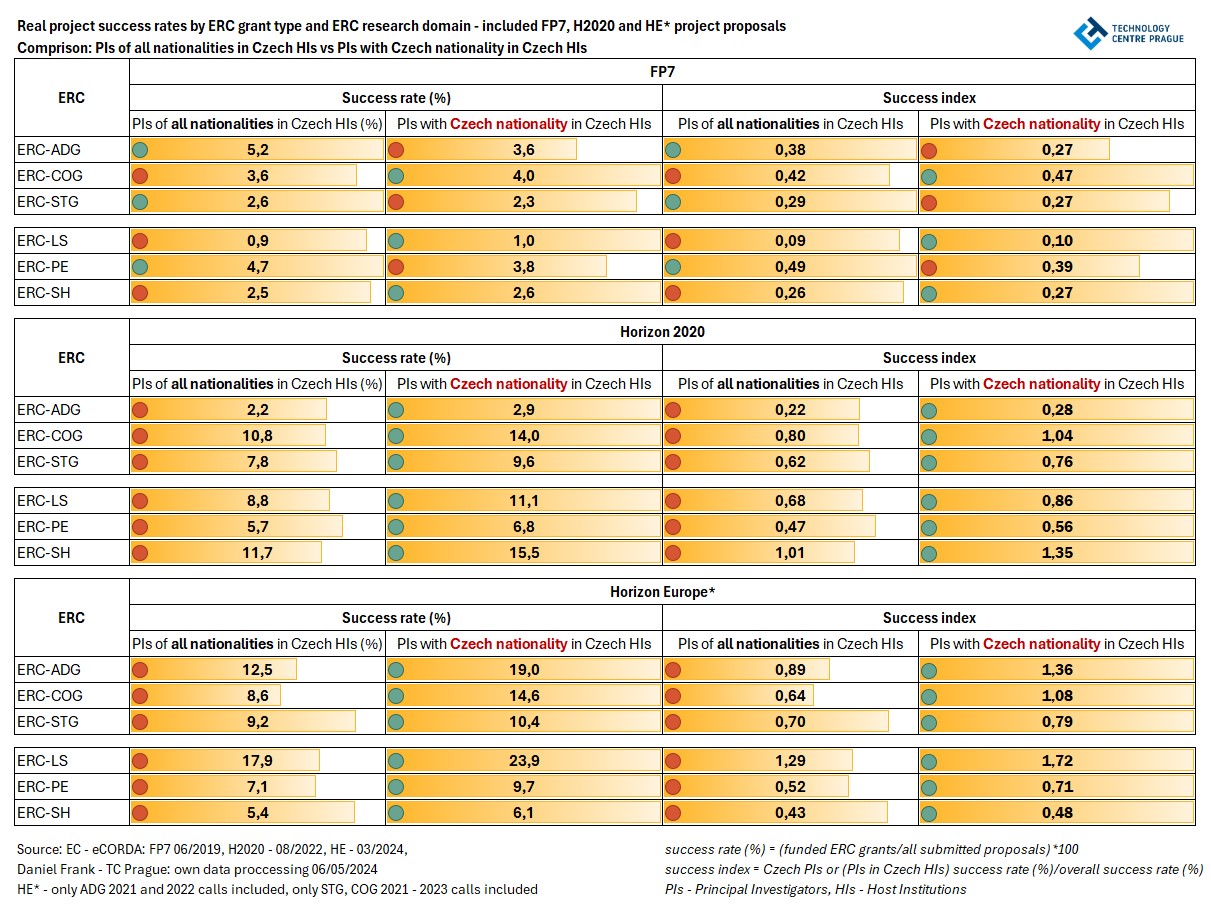
Table 2: Real project success rates by ERC grant type and ERC research domain - included FP7, H2020 and HE* project proposals. Comprison : PIs of all nationalities in Czech HIs vs PIs with Czech nationality in Czech HIs
Final summary:
High quality and verifiable results, an international reputation and groundbreaking research are the basic requirements that a project proposal and its author should have in order to succeed in the highly competitive ERC grant application process. The above results of this analysis show that the level of ERC grant applicants and the scientific quality of project proposals submitted to ERC calls for proposals to be solved in Czech host institutions has been insufficient in the long term in European comparison, although the success rate of project proposals has been gradually increasing in general. The improvement in the quality of project proposals submitted to ERC calls in the Czech Republic is mainly driven by domestic researchers. Despite the increasing attractiveness of the Czech Republic as a scientific destination, Czech research institutions have not yet succeeded in attracting a higher number of holders of these prestigious grants from abroad.
The success rate of project proposals submitted to ERC calls with the intention to work in Czech host institutions generally decreases with the complexity of preparing an ERC project proposal and the increasing length of the ERC grant applicant's scientific career. The success rate is lowest when preparing project proposals for ERC-ADG calls, which are intended for experienced, active and productive researchers who have not yet passed their career zenith. The preparation of these grants is considered more difficult than for ERC-COG and ERC-STG applications for junior researchers. For more details see e.g. [1]. In terms of research domains and panels according to which project proposals are classified, project proposals related to the life sciences (ERC-LS) have a significantly increasing success rate over time. This increasing trend in success rates for these project proposals is mainly driven by younger career researchers - applicants for ERC-STG and ERC-COG grants.
While the project success rate for ERC grant submissions related to the Czech research environment is slowly increasing over time, the activity of applicants for all three types of ERC grants related to the Czech research environment is not increasing over time, but rather stagnating. The activity of applicants intending to work on ERC grants in Czech host institutions in all three FPs compared is comparable to the European average for grants intended for early stage researchers (ERC-STG). On the other hand, the lowest activity is among senior researchers for Advanced Researcher Grants (ERC-ADG). In the long term, the most active are researchers intending to pursue an ERC grant in the physical sciences (ERC-PE). The activity of ERC grant applicants in the life sciences (ERC-LS) in Horizon 2020 and in the HE programme to date is comparable to the European average.
According to the methodology used in this analysis, all activity and success index values by grant type and research domain should ideally be in the upper right quadrant and close to 1.5. The Czech Republic is still very far from this. However, the above results suggest that support for the systematic development of young scientists in the Czech Republic is improving over time in the context of ERC grants, as indicated by their increasing activity and success rates compared to the European average. This trend is undoubtedly due to the establishment of the National Expert Group to support applicants to European Research Council (ERC) calls in January 2021 [2] and national sources of financial support for excellent early career scientists. To complete the picture, we also present Figure 7, which provides a detailed view of the success and activity indexes of applicants when submitting ERC project proposals to be addressed in Czech host institutions in FP7, H2020 and HE by ERC research domain and by ERC grant type.
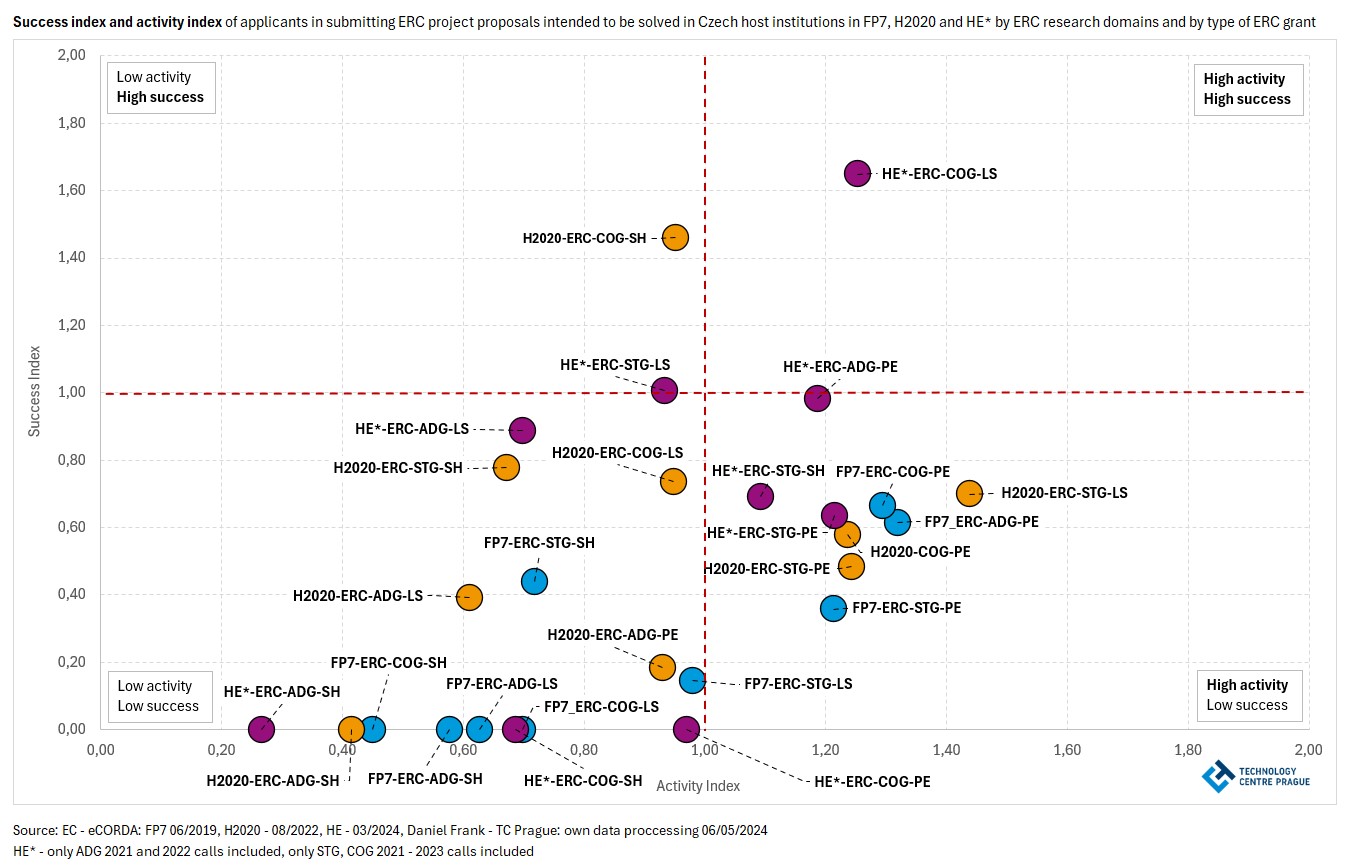
Figure 7: Success index and activity index of applicants in submitting ERC project proposals intended to be solved in Czech host institutions in FP7, H2020 and HE* by type of ERC grant and type of ERC research domains
Author: Daniel Frank, TC Prague, frank@tc.cz
Data sources:
[1] What’s unique about ERC AdG (Advanced)? https://enspire.science/unique-erc-adg/
[2] Expertní skupina na podporu žadatelů ve výzvách ERC/Informace | Portál Horizont Evropa. https://www.horizontevropa.cz/cs/struktura-programu-he/excelentni-veda/evropska-rada-pro-vyzkum/expertni-skupina-erc/informace. Dostupné 9. 5. 2024.
15/11/2024
09/09/2024
12/08/2024